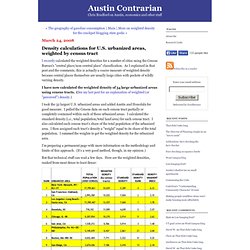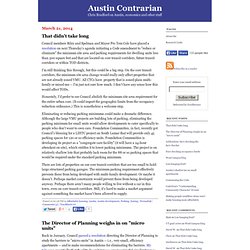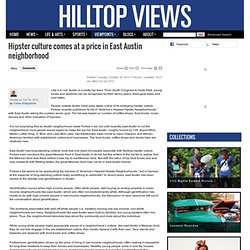

Density calculations for U.S. urbanized areas, weighted by census tract - Austin Contrarian. I recently calculated the weighted densities for a number of cities using the Census Bureau's "central place/non-central place" classification.

As I explained in that post and the comments, this is actually a coarse measure of weighted density because central places themselves are usually large cities with pockets of wildly varying density. I have now calculated the weighted density of 34 large urbanized areas using census tracts. (See my last post for an explanation of weighted (or "perceived") density.) I took the 32 largest U.S. urbanized areas and added Austin and Honolulu for good measure. I pulled the Census data on each census tract partially or completely contained within each of these urbanized areas.
I'm preparing a permanent page with more information on the methodology and limits of this approach. But that technical stuff can wait a few days. (Chart on Scribd) This approach obviously does a much better job of reflecting our perceptions of a city's density. Related posts: Austin Contrarian. Councilmember Spelman is trying to determine whether we can do something about affordability with micro units: Thanks to Austin City Council Member Bill Spelman, who’s concerned about spiraling local housing costs, the city will look into a possible way to help more folks get a little place of their own.

The operative word here is little, and Spelman, who doesn’t shy from big ideas (he also thinks we might need a local subway system), is serious about this small idea. It’s called “micro-housing.” “This is an affordable housing issue,” he told me. “What we’ve found in other urban markets is that, as construction prices get close to $300 per square foot, young folks are willing to consider living in much smaller than traditional apartments.” Affordable housing math is simple: Costs can be reduced by cutting per-square-foot prices or by buying or renting fewer square feet. Spelman is thinking pretty small, as in apartments of 300 to 500 square feet.
This is an empirical question. Hipster culture comes at a price in East Austin neighborhood - Hilltop Views : Viewpoints. Like it or not, Austin is a pretty hip town.

From South Congress to Hyde Park, young locals and students can be recognized by their skinny jeans, fixed-gear bikes and iced lattes. People outside Austin have even taken notice of its emerging hipster culture. Forbes recently published its list of “America’s Hippest Hipster Neighborhoods,” with East Austin taking the number seven spot. The list was based on number of coffee shops, food trucks, music venues and other indicators of hipness. It is not surprising that an Austin neighborhood made Forbes’s list, but until recently, east Austin is not the neighborhood most people would expect to make the hip list. East Austin has long-standing cultural roots that one does not usually associate with fleeting hipster culture.
For people on the move, Austin is a place to stop and live. What’s the difference between the nation’s capital and the so-called live music capital?

The answer reveals as much about the lure of Austin as it does about why, in September 2011, Erin Hallagan and her boyfriend, Matt Nikolajevic, quit what they considered great jobs, rolled the dice and left Washington, D.C., for new lives in Austin. “In D.C., the first question a stranger will ask you is, ‘What is it you do for living?’ They’re looking for networks to advance themselves,” Hallagan said.
“In Austin, the question is, ‘What is it you like to do?’ It’s more about self-nourishment and development. Hallagan, 27, was a film and theater major in search of a film community. Nikolajevic, 28, who graduated with a history degree from George Mason University and worked for a culinary school in Washington, now works in the admissions department at Le Cordon Bleu College of Culinary Arts in Austin. “Austin hits the trifecta. Jobs typically are the top reason people move.
The downside of popularity. The Stagnant City: How Urban Politics Are Stalling Growth and Pushing Rents Up. Downtown Austin Condo News. Austinite Tips » An insider's guide to the best, worst, and weirdest that Austin has to offer Austinite Tips. A blog about Austin public policy and policymakers.